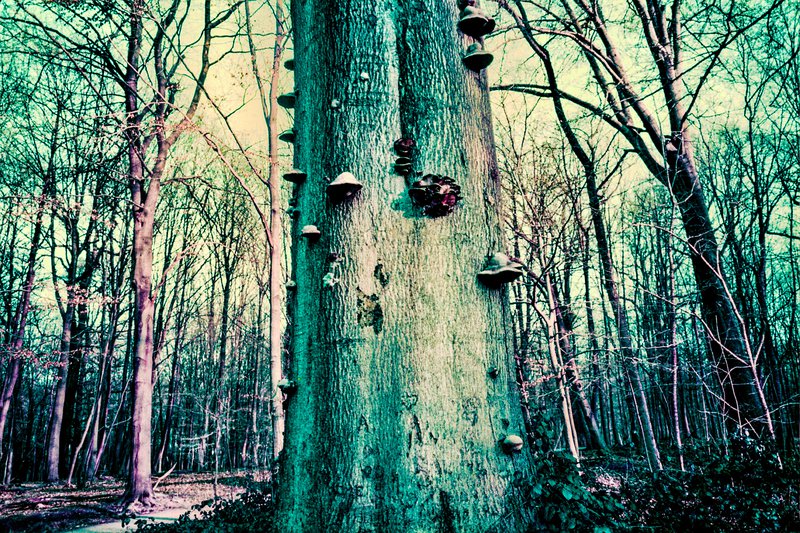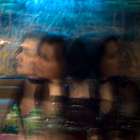Terrafictions

Abstract
The work of care in the Anthropocene is a struggle with scale and scope and sentience. If we assume that the entire material bestiary has some form of sentience, how do we respond to climate change or mass extinction? Maybe in order to care across spatial and temporal scales — to care for a loved one as much as for an eroding hill or decaying infrastructure — we need alternatives to the current cultural imaginaries. We need new stories to live by. New or alternative myths, drawn from ever more diverse mythologies. We could broaden the spectrum of biological and geological metaphors we use for human behaviour. Or spread the stories of contemporary speciation. New lineages, new hybrids, new species and migrants better adapted to changing conditions on Earth. It's humbling and perhaps heartwarming to realise that whatever happens to humankind, life on Earth will continue, in yet unknown, unknowable forms. Perhaps we'll become extinct, perhaps we'll continue our process of speciation. Or thrive in technologically sustained human refugia.

The article is adapted from FoAM's presentation at Coded Matter(s): Terra Fiction event in Amsterdam.
Full text
Terrafictions
So here we are, in the year 2018 (of the Common Era), Year 35 (Earth Dog) of Cycle 78 (for the Chinese), Heisei 30 (for the Japanese),1440 (if you are Islamic), 5779 (in the Hebrew calendar), 2562 (for the Buddhists), 5119 of Kali Yuga (according to the Hindus) and 3184 (for the Discordians). If you are using the Earth’s geological calendar we are leaving the Holocene epoch. We are now at the beginning of the Anthropocene.
Here is a city, enfolded in the long, slow temporality of the desert. The experiential time of spiders, snakes and cacti. For long periods nothing at all happens, then suddenly the city bursts into ecstatic action, like desert blossoms after a rain. This city is accustomed to oscillations of time and resources. Its once insatiable economic growth is gradually superseded by an atmosphere-based economy. The city does not shy away from its own shadow. The shadows of dust storms, water shortages, gun-slinging individualism, heat delirium and venomous critters. The shadows hiding in the fickleness of the desert and its inhospitable heart. This is a place that seeks out shade and shadows. Multi-trunked mesquite marquees diffuse light across outdoor kitchens and intimate courtyards. Solar-powered screens radiate the shadow forecast and a cooling breeze. Shade architecture, shaded transport, sheltered time. A cityscape layered with a latticework of porches, verandas, galleries, awnings, canopies, umbrellas, trees and pergolas…
— Dust and Shadow Fieldnotes #2
On the other side of the planet, a different pergola…
A permeable edge, a transition, an archway. Under the pergola light and shadow overlap, wiggling, shimmering. Sunlight is softened with shades of shadow. An uninterrupted flow between inner and outer landscapes. A queer ecology of inception and subsiding. A temporary refuge committed to the gradual dissolution of its boundaries. A place with an expiration date. A symbiotic zone, porous and promiscuous. Porous to the point of becoming ephemeral. Conviviality emerges effortlessly under the shade of a pergola. A graduated sense of closeness that includes those at a distance and those that hide in plain sight. The conversations are entangled with the sound of growing plants, crackling wood, expanding rocks, crawling insects, and the invisible signals emanating from all-pervasive digital devices. Resonant, animated matter. Divergent voices signalling, interpreting and misinterpreting. Out there (right here) beyond human perception, rocks flow fluidlike and dust speaks to dew, voices trailing in the wind, barely heard…
Across the continent, a tiny island in a vast archipelago…
It seems serene and benign yet harbours hidden disturbances, spectral hostilities. Plagues of ticks and microplastics overlaid with psychic memories of the oppressed and abandoned. Environmental anomalies hover on the edges of perception, cunningly invasive even to a casual visitor. The sea is sparsely populated, biodiversity dwindling, beset with its own ecological ghosts of oceans past. The island bides in silence, weathering the changing weather. The landscape is always on its way to becoming something else, without resistance. Things come, interfere and move on. Sail away, disappear or die out. Other things remain, as ambivalent hosts or liminal lingerings. Real but not necessarily physical, real but not always measurable. Whether invaded by crabs, humans or ticks, the island continues its slow and steady rise above the shallow waters, unperturbed…
— Spectres in Change, Fieldnotes #1
Beneath and between it all, the noise of life unfolding. A thick, almost viscous silence. The rich texture of being present in the world. Within this state of alert yet receptive presence, abstract data become tactile sensations, beckoning rather than elucidating. Noticing becomes a re-animating force, an act of caring…
Spaces of care
To care, to cure, to comfort. To be with. To help cope, regardless of the situation. “Being with” involves allowing yourself to be touched by the joys and sorrows of another. To be touched by external circumstances, or as the Dutch so eloquently say, to be “ontroerd”. Thrown off-course by the sheer rawness of the moment, by your own inability to make things better, by our fragility, impermanence and mortality.
We learn to “be with” when looking after a sick child, tending to a garden, or when caring for the dying. “Being with” a person or a process that you can’t quite understand can be frightening and uncomfortable, yet it can also become an instrument for discernment, a compass for navigating ambivalence. Care first, do later.
The work of care in the Anthropocene is a struggle with scale and scope and sentience. What does care for a dying forest look like? For an unstoppable flood? For the endless migration of humans and other animals? For an out of balance microbiome in one’s gut? If we assume that the entire material bestiary has some form of sentience, how do we respond to climate change, mass extinction or speciation? Even if we are not directly responsible for the causes, each of us is responsible for how we live with the consequences. Responsible to and for each other.
Do you care? How do you care? Where do you learn how to care? How can you care for something able to consume you completely?
The space of care exists in parallel to the space of “problems” and “solutions”. Underneath the litany of blame and judgement. Beneath social systems and ecosystems. Beneath worldviews and opinions. Deep, deep down in a place where words and worlds are intertwined. Where myths and metaphors grow from the direct experience of entangled relationships. Transferred through a touch, a broken bone, a bedtime story.
The patterns of care solidify through repetition. From thoughts to words, from words to actions, from actions to habits and from habits to character. From a person to a clan to a culture. This process takes time. An instant in geological time, generations in human time.
Maybe in order to care across spatial and temporal scales — to care for a loved one as much as for an eroding hill or decaying infrastructure — we need alternatives to the current cultural imaginaries. They need queering and complexifying. We need new stories to live by. New or alternative myths, drawn from ever more diverse mythologies.
Broadening imaginaries
What if we begin by broadening the spectrum of biological and geological metaphors we use for human behaviour? Aggression, for example is often justified by our origins as primates. Supremacy and selfishness by the survival of the fittest. Hierarchies because we share a common ancestor with lobsters. If these are seen as appropriate metaphors, what are some inappropriate ones? Metaphors and stories that spark a wider range of imaginaries.
For example, we also share common ancestors with cephalopods, fungi and micro-organisms. We could broaden gender discussions with the 36,000 sexes of fungi, or hermaphroditic snails, or fish that can change sex. We could develop non-verbal communication inspired by octopuses, who can change the colour, shape and texture of their skin. Their distributed nervous system could become a metaphor for the human exo-nervous system, as it extends through networks of connected devices.
For resilience and anti-fragility in hostile environments, think of the Endoliths — organisms that can live inside rocks, crevices of animal shells or the pores between grains of minerals, filling ever more extreme niches. They can live many kilometres beneath the Earth’s surface, surviving without water, feeding on iron, sulphur and other inorganic material. Alongside the superheroes from Wakanda, The Invisibles or The Anachronauts, could the Deinococcus radiodurans become an archetypal hero of our times? “The world’s toughest bacterium” able to survive radiation, cold, dehydration, vacuum and acid. Imagine our bodies with such bacteria living on our skin.
What we consider our “selves” are already shared spaces, colonised by symbiotic bacteria. Our bodies survive on mutualism. Approximately 2% of the human body consists of micro-organisms. By weight, equivalent to the brain. We contain roughly the same amount of microbes as non-microbial cells. Our life depends on interspecies co-operation and yet we usually fail to engage with our symbionts as collaborators. What if IBS was treated as an unfortunate miscommunication between the nervous system and gut flora? Food becomes a communicative medium, modulated by embodied mindstates. Each meal a story to tell, with stress and fermentable sugars as its main protagonists.
There are beings that thrive in our bodies, while others thrive in our wake, in exclusion zones like Chernobyl or abandoned mines. There are now sparrows in the old mining towns of Broken Hill and Mount Isa that have evolved to avoid lead poisoning. There are plastic eating bacteria and extremophiles living on industrial waste. Evolution responds to a changing environment, accelerating in step with anthropogenic change.
The flip-side of mass extinction are the stories of contemporary speciation. New lineages, new hybrids, new species and migrants better adapted to changing conditions on Earth. It’s humbling and perhaps heartwarming to realise that whatever happens to humankind, life on Earth will continue, in yet unknown, unknowable forms. At the same time, it is eviscerating to contemplate the possibility of human extinction. It’s hard to comprehend the loss of a single life, let alone the loss of entire species, the loss of everyone and everything you have ever known.
All macroscopic matter copes with some form of erosion, senescence or entropy. Mortal coils inevitably unwinding, over days, decades, millennia or aeons. Perhaps we’ll become extinct, perhaps we’ll continue our process of speciation. Or perhaps we’ll thrive in technologically sustained human refugia. In secluded monastic habitats and libraries of human life on Earth. Places where the biomass of terrafiction accumulates, growing as its spills over into books and libraries and literatures, gradually becoming an ambient literacy of human co-existence with the planet.
Terraforming
And yet, how to resist the impulse to leave it all behind and start again, somewhere else in the universe? To leave the planetary cradle, to explore, to renew, to terraform.
We don’t need to leave earth to see the effects of human terraforming. Think of the Dutch polders. Or Singapore. Or Stalin’s Great Plan for the Transformation of Nature. Every road and dyke, every chocolate factory, every farm and piece of recycled aluminium. To get a sense of how much humans have shaped the Earth, the mass of the human technosphere is an order of magnitude larger than the mass of all plant life. The infrastructure that supports our contemporary lifestyles and the waste it produces is estimated at about 30 trillion tons of carbon, or 30,000 gigatonnes. In contrast, plants make up the largest percentage of earth’s biomass, estimated at about 450 gigatonnes of carbon. For further comparison, the biomass of all living humans make up a mere 0.6 gigatonnes of carbon, roughly equivalent to about 6 million whales.
Terraformation. Shaping earth, or making of soil. Terraforming as composting and gardening rather than planet-wide engineering. In this sense humans have been terraforming Earth for millennia. Making the planet more hospitable to humankind, making soil to grow food. Terra preta in the Amazon Basin, for example, a fertile anthropogenic soil made over centuries by composting charcoal, bone and manure. Or the rice terraces of Bali that are kept productive by generations of priests and farmers, who encode their irrigation plans in calendars of ceremonial observances. A convoluted enfolding of culture and nature.
Terraforming. Making places habitable by humans. It’s a process of cultivating somewhere to live. A shelter to keep the monsters at bay, to keep us safe in hostile environments. In improbable places on Earth and beyond. Terraformers are home-makers, the housewives of the stars.
Beyond Earth (diaspora, decolonisation…)
Before terraforming other planets, humans have to be able to leave Earth. How will we leave our ancestral home? Like rebellious teenagers, curious explorers or frightened refugees? How we leave matters as much as where we go. Why we travel to the stars matters. Our intentions, attitudes and habits matter. These are the seeds of the human diaspora.
Think of the deep scars that Earth-bound colonisation has left. If humans are capable of such inhumane treatment of humans, what will happen as we spread through the solar system? As we encounter beings that we can barely comprehend as alive…
Why wouldn’t cosmonaut training include a crash-course in post-human animism and panpsychism? Wouldn’t the new space travellers need to meditate on the nature of ‘the void’ to make it across the darkness between stars? Alongside technological and scientific skills, the pioneers could be drilled in mythic cultural imaginaries, ethically convoluted games, psychological endurance, and a wide spectrum of speculative literature.
There are many stories from many cultures about making other places habitable. They all point to different approaches to being human on and beyond Earth. They tell us about the speciation of humankind, shaped by their new environments. Desert cultures on Mars. Atmospheric cultures on Venus. The thalient inhabitants of Ventus. Living with our ancestors among the stars. Civilisations as stars. While humans might set out to terraform other planets, we will inevitably be shaped by them in return.
Terraforming internal landscapes
For now though, not just our technologies but also our cultural capacities are inadequate for the task of successfully terraforming another planet. Many aspects of our cultures are still tainted with anthropocentrism and xenophobia. So how do we imagine surviving in a place where the very ground under our feet is alien?
Perhaps the most urgent terraforming required is that of our internal landscapes. Widening the reach of the human sensorium. Channeling emotional storms and the inner weather. Cultivating the imagination. Tending to the larval formation of thoughts. Exploring the depths through introspection and meditation. Transforming reactions into responses. Activating the unknown with the help of psychedelics. Entangling our grey matter with seeing machines. Finding ways of embodying others’ mindstates. Rewiring our neural pathways with cognitive therapies or biotech.
Until we stop taking ourselves so seriously (or not seriously enough). Until our individual identities are shattered and smeared and re-congealed innumerable times. Until we understand that we exist because of and despite relating to everything else. Until we understand that we are hydrogen ripped from its context, mixed with the dust of dead stars. That we are endlessly recycled water and crystalising cyclones. That we are teeming civilisational hosts. Most importantly, that we are capable of care. To care for humans and to care for the earth. To care for the earth without humans and for humans without the earth.
To take heed from the Overstory. “Keep still. Wait. Something in the lone survivor knows that even the ironclad law of Now can be outlasted. There’s work to do. Star-work, but earthbound all the same.”
Further reading
- Octavia Butler. The Xenogenesis Trilogy
- Italo Calvino. Cosmicomics
- Greg Egan. Diaspora
- Donna Haraway. Staying with the Trouble
- N.K. Jemisin. The Broken Earth Trilogy
- J. Stephen Lansing. Priests and Programmers
- Ursula K. Leguin. The Hainish Cycle
- Alphonso Lingis. The Imperative
- Cixin Liu. The Remembrance of Earth’s Past Trilogy
- Tim Morton. Humankind
- Nnedi Okorafor. The Binti Series
- Richard Powers. The Overstory
- Martin Shaw. A Branch from the Lightning Tree
- Kim Stanley Robinson. The Mars Trilogy, 2312
- Karl Schroeder. Ventus
- Olaf Stapledon. Star Maker
- Isabelle Stengers. Reclaiming Animism
- Neal Stephenson. Anathem
- Anna Lowenhaupt Tsing. The Mushroom at the End of the World
- Gordon White. Star.Ships
- E.J. Michael Witzel. The Origins of the World’s Mythologies
- Ed Yong. I Contain Multitudes
- Lidia Yuknavitch. The Book of Joan



